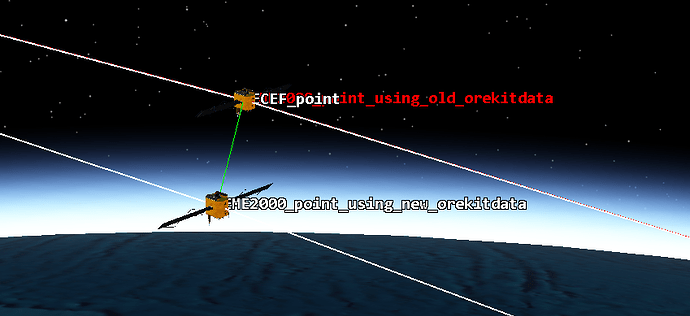Hello everyone!
I’m using orekit through the python wrapper.
I updated my local orekit-data.zip because the one was using before it’s very old
Old version: Updated with aprill 2022 data. (3981e68c) · Commits · Orekit / Orekit Data · GitLab (19 April 2022)
New version: updated to March 2024. (4f95ffad) · Commits · Orekit / Orekit Data · GitLab (17 March 2024)
My orekit version is 11.3.3
I made some tests to check how the update of the orekit-data.zip is influencing my simulator in terms of propagation and reference frame conversion. I notice that using the new version of orekit-data.zip my results on reference frame conversion are worst.
So using the following point, which is in ECEF
Instant: 2024-05-27T09:49:26.703Z
Position: [3931.8886855634414,4882.664580844832,-2827.6958795134237]
Velocity: [-0.7393581869670774,-3.3909482489911196,-6.866712111908378]
and converting it to EME2000, using the following code
inertialFrame = FramesFactory.getEME2000()
fixedFrame = FramesFactory.getITRF(IERSConventions.IERS_2010, True)
point_date = datetime_to_absolutedate(point['Instant'])
point_position = Vector3D(point['Position'][0]*1000.0, point['Position'][1]*1000.0, point['Position'][2]*1000.0)
point_velocity = Vector3D(point["Velocity"][0]*1000.0, point["Velocity"][1]*1000.0, point["Velocity"][2]*1000.0)
ecef_tpv = TimeStampedPVCoordinates(point_date, point_position, point_velocity)
transform = fixedFrame.getTransformTo(inertialFrame, point_date)
tpv = transform.transformPVCoordinates(ecef_tpv)
Using the old version of orekit-data.zip tpv is:
{2024-05-27T09:49:26.703, P(686544.8029968282, 6230440.403643706, -2829539.651928883), V(727.5319561418162, -3206.94615903976, -6868.339932521091), A(0.4713588457669586, 0.1416019228785583, -0.0011184269861723862)}
Using the new version of orekit-data.zip, tpv is:
{2024-05-27T09:49:26.703, P(686561.8282723054, 6230434.173183345, -2829549.239950467), V(727.5357752399009, -3206.959040348474, -6868.332656847968), A(0.4713608150897179, 0.14160244422760146, -0.0011184316565229246)}
The difference in range between the two points is around 20m
Here a screen shot on STK for better visualization
Could be something related to the orekit version and orekit-data verison? Like certain orekit-data versions only work properly for certain orekit versions?
